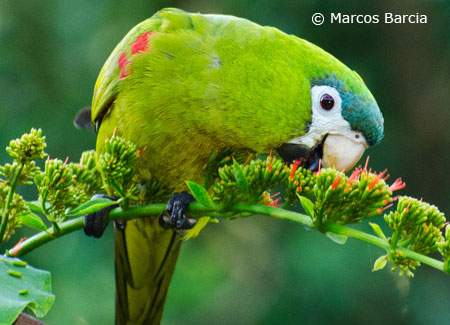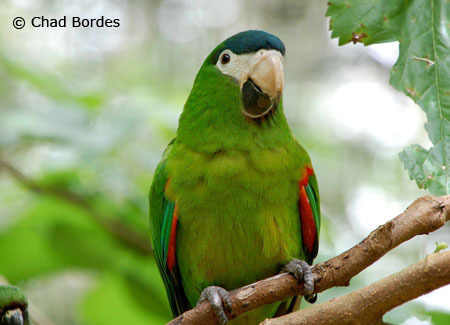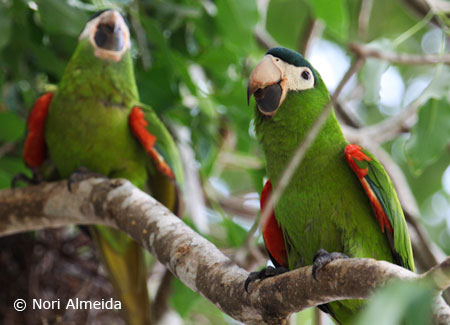[bars]
Common Names: Red-shouldered Macaw, Mini Macaw, Han’s Macaw
Scientific Name: Diopsittaca nobilis
Origin: Venezuela, Guianas, Colivia, Brazil, Peru
Relative Size: 14 & 15 inches
Weight: 190-200 grams
Average Lifespan: 30-40 years
Egg Clutch: 2-5 white eggs
Incubation: 24-25 days
Talking Ability: Moderate
General Information On Noble Macaws

The Noble Macaw is one of three macaws that fall into the Red-shouldered Macaw family. This bird looks very similar to its cousin the Hahn’s Macaw and is relatively the same size, but it’s just a tad bit bigger. The birds look very similar in that people often find it difficult to differentiate between the two species; however, there are differences.
Noble Macaws have relatively larger beaks in comparison to a Hahn’s Macaw. Not only are their beaks larger, but the upper mandible (beak) is beige while the lower mandible is black. A Hahn’s Macaw usually has a solid black beak with only a very slight amount of beige coloring on the top mandible. You have to look closely for the differences, but you can detect them if you know what you are looking for. With the Noble Macaw, the beak is more proportional to the parrot body giving the macaw a conure-like appearance.
[ads]
A Noble Macaw has a base color of green throughout its body. These darker shades of green are accompanied with olive green hues that make this bird a remarkable specimen. When a Noble Macaw is juvenile, they look relatively green and kind of “plain.” As the bird matures, it will acquire a blue cap upon its head and red shoulders—hence why they classify it as a Red-shouldered Macaw.
These mini macaws also have white patches of skin around their eyes. The eyes of this parrot are a fiery orange with black pupils. When the parrot becomes excited, many owners will see their parrots eyes pin—this can especially be seen when the parrot is talking.
These birds do have relatively large feet in comparison to their bodies. Two toes are pointed forward and two toes are pointed backwards. This arrangement of toes allows them to manipulate objects within their environment. In addition, a Noble Macaw is about 14 inches in length and the tail makes up a large part of the parrots size.
Noble Macaws in the Wild

Noble Macaws in the wild are very outgoing and sociable. Like most South American parrots these birds do not mind flocking with other parrots such as Amazons or Conures. These social creatures thrive in flocks and can be seen together during late noon and before sunset; however, they do roost in smaller numbers in the wild.
During the day, a great amount of their time is spent foraging, playing, and flying. When not participating in flock dynamics most Noble Macaws will spend a great deal of their time with their mates. These parrots form strong bonds with each other and will mate for life.
When the birds are gearing up to breed they will look for a hollow opening inside a tree. The female will expand the cavity before eggs are laid. While the female is incubating her clutch, the male will keep watch for any danger.
The babies usually wean between 10-14 weeks and will remain with their mothers until they have learned the flock dynamics, foraging, and basic survival skills. Though not enough research has been done during the time a juvenile stays with his parents, it is estimated these mini macaws stay about a year before they are expected to act independently—some lager macaw juveniles will remain with their parents for at least 18 months before they venture off.
These parrots make their home and best survive in topical lowlands. Their green coloring is perfect for camouflaging into greenery environments. Some Noble Macaws also prefer the swamplands as this too is suitable for them.
Noble Macaws in Captivity
At one time Noble Macaws were caught by the hundreds and imported into the United States. This was allowed. This practice has since stopped due to current laws ceasing the importing of exotic birds and because the Noble Macaw is on the list as a Convention on International Trade in Endangered Species (CITES) specie. Before this law, many birds were either trapped or their nesting sites robbed for the removal and selling of these chicks. Because of these parrots being listed as endangered due to over trapping and environmental destruction, we have been able to stabilize and maintain these bird populations despite the other obstacles that plague them.
In terms of breeding for captivity, these birds breed readily without too much interference. Most wild caught Noble Macaws only need proper housing, privacy, and a healthy diet to successfully produce. This allows for these birds to multiple easily; therefore, allowing them to become a popular pet to have.
Many Noble Macaw breeders are dedicated advocates of allowing their birds to successfully raise their own young as this creates a healthy breeding stock for feature breeders. If the babies are pulled for hand feeding and become too tame, it is highly unlikely they will ever produce successfully. For this reason, many breeders feel the responsibility to ensure the parrots they produce are not handfed.
If a bird enthusiast wishes to purchase a Noble Macaw, the best place to look would be their local bird club, bird shows, or classified ads. These macaws are not too difficult to come by as local breeder specializing in Noble Macaws can usually be located.
Noble Macaws as Pets
Noble Macaws make wonderful pets if purchased as handfed babies. These parrots are known for their charming, docile, and clown-like personalities. It is important that the bird be exposed to as many people, environments, handling, and different toys before it matures. This socialization process is a must if the owner wishes to get the most out of their pet Noble Macaw.
These gregarious parrots thrive on lots of interaction and attention. In fact, it is detrimental to these birds to keep them isolated and away from normal family interactions. It is important all family members partake in interacting with the pet Noble Macaw from the beginning.
For example, the bird can be handled while watching television or placed on the owner’s shoulder while the family meal is being prepared, while on the computer, or just doing normal everyday chores. In the morning, some owners will place a stand inside the bathroom for their bird while they are showering. The birds tend to enjoy the humidity in the air. This is just another way to interact with the bird throughout the day.
Noble macaws do not make great apartment birds due to their loud calls and may disturb neighbors. Though these parrots may be small compared to most macaws, they still make loud contact calls that can be expected during the morning, noon, and before sunset. For this reason, owners should check with their neighbors to ensure the excessive noise does not bother them.
Because these birds are native to the forests of South America, they have been designed to be loud. Owners should be aware of this before they purchase the bird. Young Noble Macaw’s can give mislead the owner to believe they are fairly quiet. If the bird should develop the habit of excessive screaming, it is important the owner completely ignore it. There is no need to scold the bird or spray the bird with water (as some people tend to do) to keep him quiet. These types of tactics may either be interpreted by the bird as abuse or maybe seen as a reward because they have gotten your attention. Nonetheless, giving this type of attention only makes the behavior worse on many levels.
These birds can become a bit nippy before they mature. If this is the case, the owner should simply ignore all biting and make every effort to handle the bird. Like screaming, it is important the owner never make a fuss about the biting as the bird will once again think that this is a way of gaining your attention. Ignoring this biting is the best method to correct this problem. Over time the parrot will know it doesn’t work and will seize to bit or scream.
Breeding Noble Macaws

When it comes to breeding the Noble Macaw, thankfully there are no extra special methods or environments needed to get these parrots started. Obviously, the birds need to have a breeder’s cage with plenty of space, a nesting box, and plenty of food and water to begin producing, but other than that, nothing else is required. Many breeders find that these macaws breed more readily if they can hear other Noble Macaws but do not see them; therefore, they block them from visually seeing these other birds.
These parrots tend to nest during the warmer months, and for this reason these birds should be protected from the sun and placed in a environment where it is a bit cooler. Also, the macaws should have plenty of water if the temperature becomes too warm. If the temperature becomes too elevated during incubation, some hens may leave the nest for a while as the heat in the environment will incubate the eggs. Breeders should not worry if this is seen, as the female will quickly return to the nest once the temperature cools down.
Noble Macaws produce between three and five white eggs. If the owner wishes to receive a second clutch for the year the eggs may be removed and placed into an incubator. It is important a parrot incubator be purchased as the temperatures needs to be precise to allow a successful hatching. Some owners may leave the eggs under their mother for a few days before removing the eggs for incubation.
The incubation period is between 24 and 25 days. The baby macaws will hatch with white down and fledge at around 10 weeks of age. Most baby Noble Macaws are weaned by 15 weeks. If the babies are pulled for hand feeding, they should be pulled when they are about 10-15 days old. The crop should be completely allowed to empty before a commercial hand feeding formula is given to ensure the birds to not get an upset stomach or sour crop.
Choosing the Right Cage
Selecting the right cage for a pet Noble Macaw is important. The bird will live in its cage throughout its life. The cage will go through lots of wear and tear from the bird, and needs to be sturdy enough to ensure it can withstand this. It’s a good reason to invest a great deal of time selecting the proper cage. Though these birds look small, a cockatiel sized cage will not do. These birds need to have larger cages because they enjoy climbing, swinging, and hanging upside down. They are extremely active birds.
The cage should be powder coated as this helps to prevent rust and makes the surface easy to clean. Other types of cages used are ones with stainless steel bars. Avoid cages that are galvanized or zinc coated as this will cause metal poisoning.
A good rule of thumb when looking for a cage is to make sure there is enough room for the bird to turn around, flap its wings, jump from perch to perch, swing freely, and play without touching the cage bars. The owner should always buy a cage as large as their budget can afford and one that will last around 20 or 30 years. Of course you can always change cages; however, remember that every time you do so, your bird has to readjust to the new environment.
In addition, these parrots enjoy toys that are made of wood and that can easily be dismantled. Toys should always be given and rotated weekly to ensure the parrot never becomes bored. A play stand is also recommended for the parrot when he is outside of his cage.
Feeding a Noble Macaw

Feeding a Noble macaw is simple and does not need to be too difficult. Most owners will prepare their Noble Macaws food while they are prepping their own meals. For example, if an owner is cutting vegetables for dinner, they also cut some for parrot as well. The vegetables can then be stored in Ziploc baggies for the week.
These birds should be given a variety of vegetables such as squashes, carrots, kale, celery, tomatoes, or other dark leafy greens. It is important all be washed thoroughly to remove any pesticides or chemicals that may harm the parrot.
Fruits are just as important as vegetables. These also can be given on a daily basis; however, they tend to leave the cage quite messy when the bird is done. All fruit items can be given on skewers to make fruit kebabs. Some popular fruit items the bird might enjoy are apples, oranges, pears, mango, papaya, kiwis, bananas, or tangerines.
Beans and legumes are just as important but it is important they be cooked well before given to the parrot.
Along with fresh fruits and vegetables, a base diet of either pellets or seeds should also be rotated into the diet. Some owners prefer to give just pellets and yet others may give their birds just seeds. It is highly debated as to which is best; however, it makes sense that all food types should be rotated routinely for a better healthy bird and to ensure that the parrot receives the necessary nutrients.
If the parrot is properly fed and taken to the vet for regular checkups, these birds can live between 30 and 50 years.
[ads]
